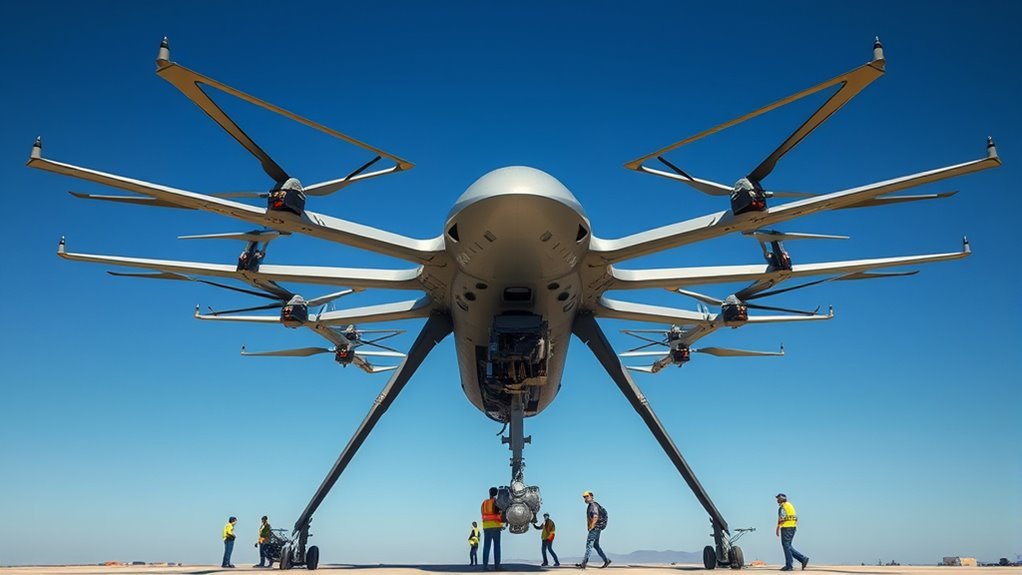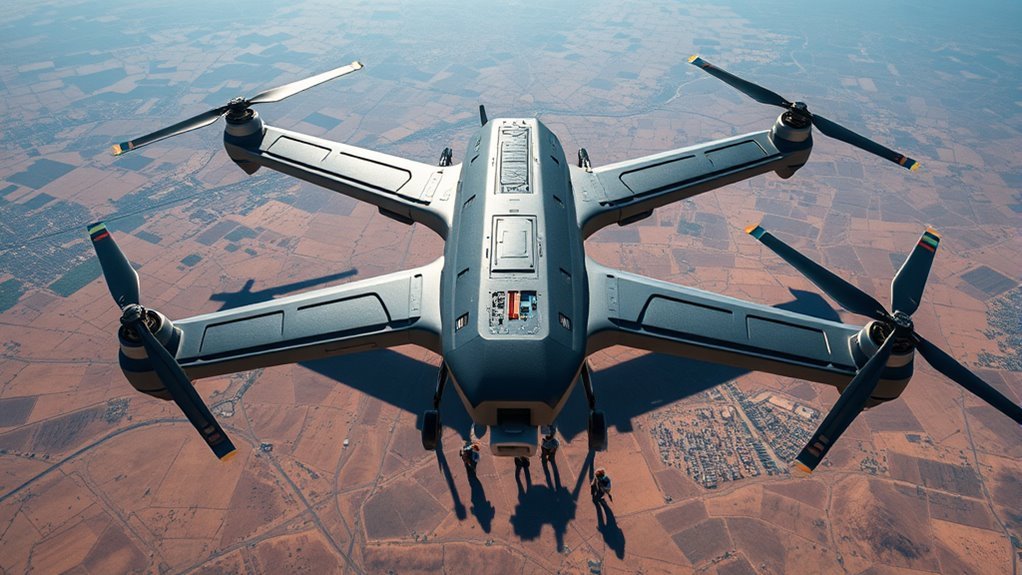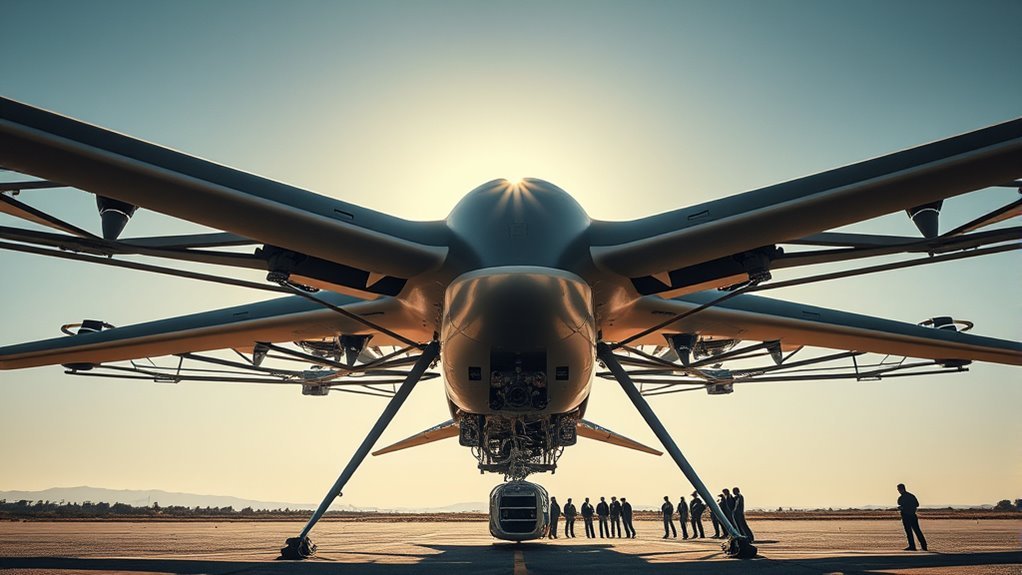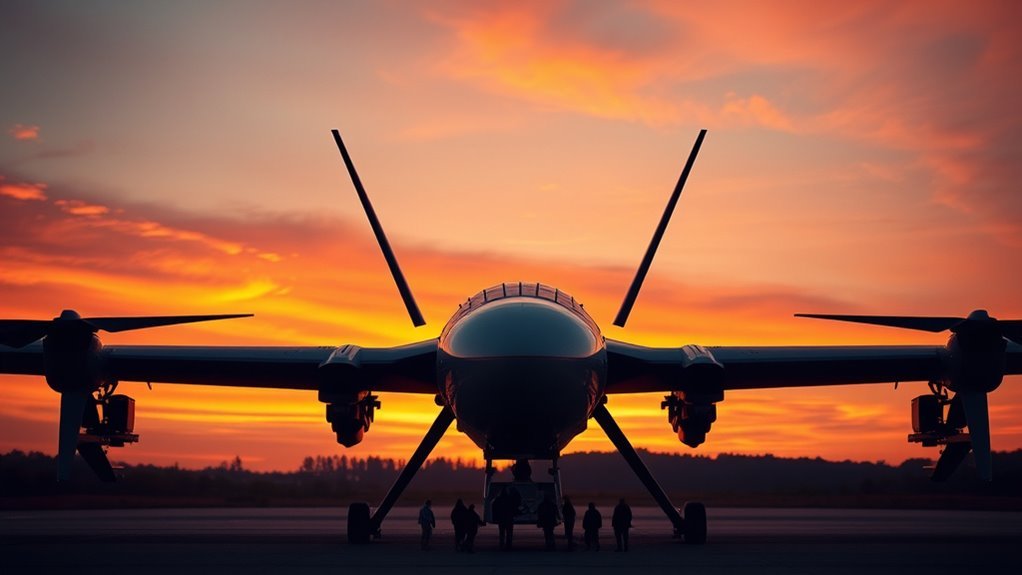The largest drones incorporate advanced engineering that emphasizes structural integrity, efficient propulsion systems, and impressive payload capacities. Their size comes from the need to accommodate cutting-edge technology and engineering solutions. Materials like carbon fiber enhance strength while keeping weight low. Additionally, hybrid propulsion systems boost flight range and versatility. Each element is meticulously designed to optimize performance and adaptability, which is essential in various applications. Discover how these factors shape the future of drone technology as you explore further.
The Evolution of Drone Size

As drone technology has advanced, the size of these devices has undergone significant evolution, reflecting both technological capabilities and user demands. You’ll notice drone miniaturization trends becoming more pronounced, with devices shrinking while gaining enhanced functionality. Historical drone comparisons highlight this shift; early models were bulky and limited, designed primarily for military applications. Today, advancements in materials and electronics allow for compact designs, catering to diverse uses such as recreational flying and surveillance. As you explore these developments, consider how size impacts maneuverability, battery life, and payload capacity. The ongoing quest for miniaturization balances efficiency and performance, empowering users to achieve unprecedented freedom in aerial exploration and data capture, reshaping the landscape of drone applications. This evolution also includes improved battery performance that enables longer flight times and more efficient operational capabilities. Additionally, advancements in battery technology have contributed significantly to extending the duration of flights, allowing drones to operate for longer periods without interruptions.
Key Design Elements of Large Drones

When evaluating large drones, you’ll need to focus on key design elements that guarantee superior performance. Structural integrity is essential to withstand operational stresses, while payload capacity determines what the drone can carry effectively. Additionally, aerodynamic efficiency plays an important role in enhancing flight range and fuel consumption, making it imperative to balance these aspects during the design process. The use of durable materials ensures that large drones can withstand various environmental conditions while maintaining optimal performance. For instance, high-capacity lithium-ion cells provide reliable energy density, allowing for longer operational missions.
Structural Integrity Considerations
Guaranteeing structural integrity in large drones is essential, particularly because their size amplifies the stresses experienced during operation. You’ll need to conduct thorough structural analysis to identify potential failure points that smaller drones might not encounter. The design must account for weight distribution, as uneven loads can lead to structural fatigue or catastrophic failure. Materials should be chosen for their strength-to-weight ratio, allowing for resilience without excessive mass. Reinforcements in critical areas can enhance stability, but they must be strategically placed to avoid unnecessary weight. Regular inspections and simulations can further guarantee that the design meets safety standards. By focusing on these key elements, you can achieve a robust drone that confidently navigates the skies while minimizing risks.
Payload Capacity Requirements
After establishing the structural integrity of large drones, attention shifts to payload capacity requirements, which are essential for optimizing performance and functionality. You’re tasked with understanding how payload optimization directly impacts operational efficiency. The design must accommodate varying payloads, ensuring that the drone can adapt to different missions without compromising stability or range. Capacity expansion is significant; it allows for the incorporation of advanced technologies or additional equipment without necessitating a complete redesign. Balancing weight, volume, and distribution becomes paramount, as these factors influence flight dynamics. Additionally, integrating modular payload systems can enhance versatility, enabling you to switch configurations swiftly based on mission needs. Overall, addressing these requirements is critical for achieving the desired operational freedom and effectiveness in large drone applications.
Aerodynamic Efficiency Design
To achieve peak aerodynamic efficiency in large drone design, several key elements must be meticulously considered. First, understanding aerodynamic principles is essential; you must analyze airflow patterns around the drone’s structure. Streamlined shapes minimize drag, enhancing performance and fuel efficiency. Next, selecting lightweight yet durable materials allows for design refinement—balancing structural integrity with weight reduction. Additionally, wing design plays an important role; larger wings with ideal aspect ratios can improve lift-to-drag ratios. Incorporating advanced control surfaces guarantees stability and maneuverability, allowing for better handling in various conditions. Finally, implementing distributed propulsion systems can enhance thrust efficiency. By focusing on these elements, you can push the boundaries of what large drones can achieve, embracing the freedom they offer in various applications.
Advanced Materials and Construction Techniques

As advancements in drone technology accelerate, the integration of advanced materials and construction techniques becomes essential for enhancing performance and durability. The use of advanced composites allows for the creation of lightweight structures that maintain strength and resilience, vital for the largest drones. These materials often include carbon fiber and fiberglass, which contribute to reduced weight without compromising structural integrity. Additionally, the incorporation of advanced AI-driven autonomy in drone design can lead to more efficient operations and better overall performance. Moreover, the NDAA compliance requirements influence the selection of materials to ensure security and reliability in drone operations.
| Material | Benefits | Applications |
|---|---|---|
| Carbon Fiber | High strength-to-weight | Airframe construction |
| Fiberglass | Corrosion-resistant | Body panels |
| Kevlar | Impact resistance | Reinforcements |
Utilizing these materials not only improves fuel efficiency but also extends operational life, giving designers the freedom to innovate further.
Powering the Giant: Engine and Propulsion Systems
To understand how the largest drone achieves its impressive capabilities, you’ll need to examine the engine specifications and propulsion technology innovations. These elements are essential for maximizing efficiency and performance, particularly given the drone’s size and operational requirements. By analyzing these systems, you can appreciate the engineering advancements that enable such a powerful aerial vehicle.
Engine Specifications Overview
While the sheer size of the largest drone captures attention, its engine specifications are critical in determining its operational capabilities and efficiency. At the heart of this giant lies a powerful engine designed for peak engine performance and fuel efficiency. Utilizing advanced materials and engineering, the propulsion system delivers remarkable thrust while maintaining low fuel consumption. The engine’s design incorporates high bypass ratios, which enhance efficiency during long-duration flights, allowing for extended missions without frequent refueling. Additionally, its modular architecture facilitates maintenance, ensuring reliability and operational readiness. You’ll appreciate how these specifications work together to provide not just power but also the freedom to explore vast distances, making this drone a marvel of modern aviation technology.
Propulsion Technology Innovations
Innovations in propulsion technology are reshaping the capabilities of the largest drone, enabling it to achieve unprecedented performance levels and operational versatility. With recent propulsion advancements, manufacturers are focusing on maximizing engine efficiency, allowing drones to fly longer distances while carrying heavier payloads. Enhanced turbine designs and lightweight materials have led to significant reductions in fuel consumption, which is critical for extended missions. Additionally, hybrid propulsion systems are emerging, combining traditional engines with electric motors to provide flexibility and sustainability. These advancements not only improve endurance but also reduce the environmental impact, aligning with the desire for freedom in operational capabilities. By harnessing cutting-edge technologies, the largest drone is positioned to redefine the future of aerial innovation.
Payload Capacity and Versatility
As the demand for aerial applications grows, understanding the payload capacity and versatility of the largest drones becomes essential for maximizing their utility. These drones excel in payload optimization, allowing you to transport a variety of cargo types, from medical supplies to construction materials. Their design accommodates modular configurations, enabling you to adapt the payload for specific missions. This cargo versatility not only enhances operational efficiency but also expands the range of potential uses, catering to diverse industries. By leveraging advanced materials and engineering, these drones can carry heavier loads without sacrificing flight performance. Additionally, the weight capacity constraints associated with drone operations necessitate careful planning to ensure compliance with safety regulations. Moreover, the integration of advanced autonomy features in drone operations can significantly improve their adaptability and efficiency during missions. As you explore the capabilities of large drones, consider how their payload capacity can align with your unique operational needs, revealing new opportunities for innovation and freedom in aerial logistics.
Applications of Large Drones in Various Industries
Large drones have transformed various industries by offering innovative solutions that enhance efficiency and expand operational capabilities. Their applications are vast, including:
Large drones are revolutionizing industries, delivering innovative solutions that boost efficiency and broaden operational possibilities.
- Agricultural Monitoring: They provide real-time data on crop health, enabling precision farming, and can utilize precision crop detection technologies to optimize interventions and minimize chemical use.
- Disaster Relief: Large drones can deliver essential supplies to hard-to-reach areas during crises.
- Aerial Surveying: They capture high-resolution images for mapping and land assessments, improving accuracy in planning.
- Cargo Delivery: With increased payload capacity, they facilitate the swift transport of goods across challenging terrains.
Additionally, they play important roles in wildlife conservation, construction inspection, film production, and scientific research, showcasing their versatility and impact across multiple sectors. Embracing these technologies can greatly enhance operational freedom and efficiency in your industry. Furthermore, large drones equipped with multispectral cameras can provide insights into environmental monitoring and crop health analysis, further expanding their utility.
The Future of Drone Technology and Size Trends
While the drone industry continues to evolve rapidly, advancements in technology and design are driving trends toward larger and more capable aerial vehicles. You might be wondering how size limitations are being addressed to release future capabilities. Larger drones can carry more payloads, enhancing their versatility for various applications. Additionally, the integration of IoT sensors in drone technology can facilitate real-time data collection and monitoring for agricultural purposes. Furthermore, larger drones enable enhanced medical supply delivery in remote areas, significantly improving access to healthcare services.
Here’s a quick comparison of trends:
| Drone Size | Payload Capacity | Future Applications |
|---|---|---|
| Small Drones | Up to 5 kg | Surveillance, Delivery |
| Medium Drones | 5 to 20 kg | Agriculture, Inspections |
| Large Drones | 20+ kg | Logistics, Search & Rescue |
As you can see, the trajectory of drone technology clearly suggests that overcoming size limitations will reveal unprecedented possibilities.
Frequently Asked Questions
What Is the Largest Drone Currently in Existence?
You’ll find that the largest drone, the RQ-4 Global Hawk, showcases advanced drone technology. Its massive wingspan contrasts with smaller models, emphasizing the evolution of aerial capabilities and the freedom they provide for surveillance and reconnaissance.
How Do Large Drones Compare to Traditional Aircraft?
When comparing large drones to traditional aircraft, you’ll find that drone capabilities often exceed aircraft efficiency in specific tasks, allowing for greater versatility in operations like surveillance, cargo delivery, and environmental monitoring without traditional limitations.
What Are the Environmental Impacts of Large Drones?
Did you know large drones can emit up to 50% more carbon than smaller models? This raises significant environmental concerns, as their ecological footprint can impact habitats and contribute to climate change, challenging your desire for freedom in nature.
How Are Large Drones Regulated in Different Countries?
When considering large drones, you’ll find that regulations vary considerably across countries. Some adhere to international standards, while others impose stricter rules. Understanding these differences is essential for steering through the global drone landscape effectively.
What Safety Measures Are in Place for Operating Large Drones?
When operating large drones, you’ll need to follow strict operational guidelines and safety protocols. These measures guarantee compliance with regulations, minimize risks, and protect both airspace and individuals, allowing you to enjoy freedom responsibly.

